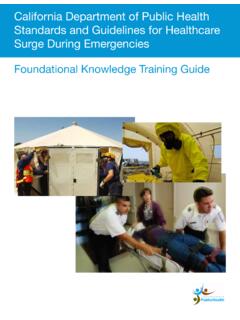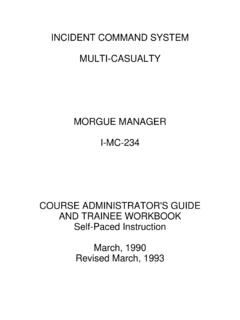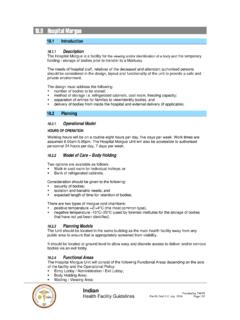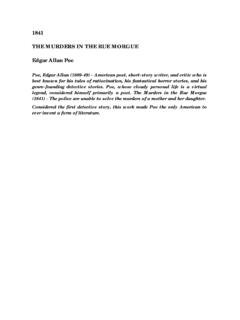Transcription of Mass Fatality Incident Management: Guidance for Hospitals ...
1 mass Fatality Incident management : Guidance for Hospitals and Other Healthcare Entities August 2008 Developed in collaboration between the following Los Angeles County partners: Department of Coroner Department of Health Services, Emergency Medical Services Agency Department of Public Health, Office of Health Assessment & Epidemiology, Data Collection & Analysis Unit Los Angeles County mass Fatality Incident management : Guidance for Hospitals and Other Healthcare Entities August 2008 1 TABLE OF CONTENTS SECTION 1: OVERVIEW Purpose.
2 2 3 County-Wide Coordination .. 4 Key Contacts .. 5 SECTION 2: HOSPITAL mass Fatality Incident (MFI) PLANNING Planning Overview .. 6 10 Questions to Get 7 Sample Table of 8 Checklist: MFI Planning .. 9 SECTION 3: HOSPITAL mass Fatality Incident (MFI) RESPONSE Hospital mass Fatality Incident (MFI) management Unit .. 13 Job Action Sheet: MFI Unit Leader .. 14 Checklist: MFI management Unit Equipment and 17 Card: Decedent Information and Tracking .. 18 Form: Fatality Tracking .. 19 SECTION 4: DEATH FLOW PROCESS Decedent Processing: Potential Bottlenecks.
3 20 Flow Chart: Death at A 21 Flow Chart: Pandemic Influenza Death at A Hospital .. 22 SECTION 5: DEATH CERTIFICATES Fact Sheet: About Death Certificates and Facts About Signing the Death Certificate .. 23 Flow Chart: Death Certificate 24 Sample: Form VS-11E Certificate of Death .. 25 Fact Sheet: California Electronic Death Registration System (CA-EDRS) .. 26 Fact Sheet: Information on the LAC Public Administrator .. 27 SECTION 6: DECEDENT HANDLING AND STORAGE Fact Sheet: Health Risk from Dead Bodies and Basic Infection Control for Staff Handling Dead Bodies 28 Fact Sheet: Human Remains Storage Myths and Truths.
4 29 Fact Sheet: Decomposition .. 32 Fact Sheet: Recommended Methods of Storage for 33 Checklist: Surge Morgue Equipment and Supplies .. 34 SECTION 7: ADDITIONAL RESOURCES mass Fatality Pandemic Influenza Exercise Sample Pre and Post Test 35 Web 37 Los Angeles County mass Fatality Incident management : Guidance for Hospitals and Other Healthcare Entities August 2008 2 PURPOSE A mass or multi- Fatality Incident (MFI) results in a surge of deaths above what is normally managed by normal medicolegal systems.
5 In the event of a major disaster within Los Angeles County, it may be several days before the Department of Coroner, County Morgue, or private mortuaries can respond, process and recover decedents. The following guidelines have been developed to aid Hospitals and other healthcare entities in their response to an MFI. While this Guidance is intended for use during a county-wide MFI, the principles can be applied anytime a hospital is experiencing a surge of deaths above what is normally managed by the hospital.
6 These principles can also be used by any healthcare entity of any size to manage an MFI. The forms and checklists are designed to be personalized by your facility as needed. This Guidance includes information on preserving and safeguarding decedents, property, and evidence. It will also discuss the processes and issues for decedent identification, next of kin notification, death certificate processing, tracking, storage, and final disposition. The goal of these guidelines is to enhance the ability of Los Angeles County and its healthcare partners to respond to and manage a surge in the number of decedents as a result of any disaster, including an influenza pandemic.
7 While the importance of religious, cultural and mental health considerations is recognized, it is not addressed here. These guidelines focus on decedent processing for medical and legal reasons. This Guidance was developed in collaboration between the Los Angeles County Department of Coroner, Department of Health Services, Emergency Medical Services Agency (EMS), and Department of Public Health, Office of Health Assessment & Epidemiology, Data Collection & Analysis Unit. This document is available for download at the EMS Web site: Los Angeles County mass Fatality Incident management : Guidance for Hospitals and Other Healthcare Entities August 2008 3 ASSUMPTIONS The Los Angeles County Department of Public Health registers approximately 57,000 deaths/year.
8 It is the duty of the Department of Coroner to determine the circumstances, manner and cause of all violent, sudden, or unusual deaths. A mass or multi Fatality Incident (MFI) results in a surge of deaths above which is normally managed by a community s usual medicolegal system. The Los Angeles County Department of Coroner is the lead agency to manage an MFI, however it is not solely responsible for all aspects of response to an MFI. Medicolegal systems may continue to experience a normal case load as well as the case load from the MFI with the possibility of an increase in accidental deaths (due to therapeutic complications and/or those resulting from the increased use and operation of motor vehicles/heavy equipment), homicidal (due to civil unrest), and/or suicide cases.
9 The Department of Coroner, Department of Health Services, Department of Public Health, Hospitals and other healthcare entities have limited Fatality surge space or equipment. Federal or military assistance in Fatality management may not be available to local jurisdictions in widespread incidents such as a pandemic. Disposition of human remains requires a death certificate. In all US jurisdictions, a treating or primary care physician is authorized to sign a death certificate provided the patient dies from natural causes and has knowledge of the causes of death.
10 Human remains do not pose additional health risks to the community. Those who physically handle remains may be at risk of blood borne or body fluid exposure requiring universal precautions and proper training for handling the dead. It is more important to ensure accurate and complete death investigations and identification of the dead than it is to quickly end the response. The time to complete Fatality management of a mass Fatality event may exceed six months to a year. Mental health professionals, social service organizations and religious leaders will have to be educated in the mass Fatality management process at all levels to ensure the process is understood and can be properly communicated to the general population in their response activities.















